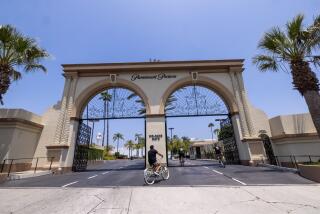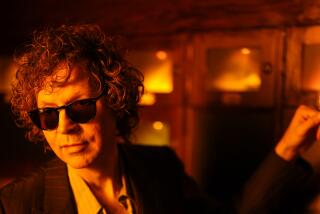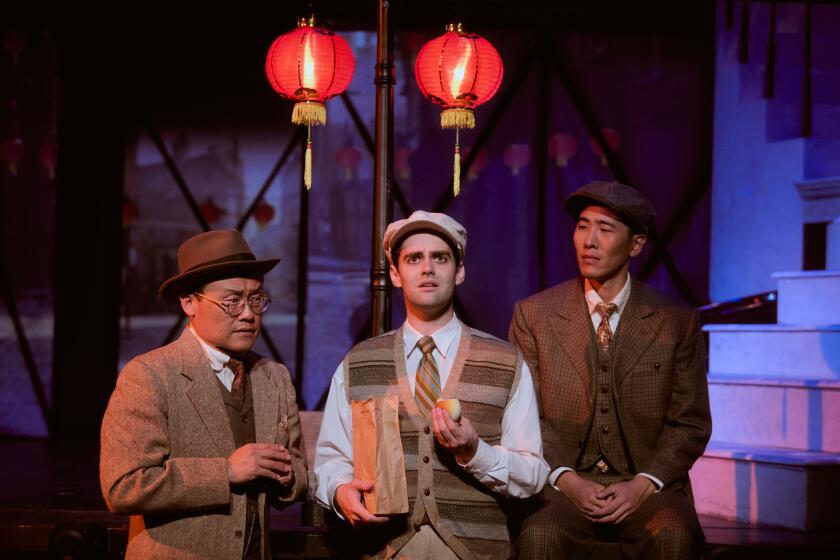Maximal exposure
If art movements were people, Minimalism would be a tough guy who sticks to basics and expresses no emotion. Think Donald Judd and his massive metal boxes, Carl Andre and his firebrick floor pieces, Dan Flavin and his fluorescent light sculptures. No fluff, no chatter, no personal touch. Just austere, geometric objects made of industrial materials.
Such is the stereotype. But curator Ann Goldstein had something different in mind when she organized “A Minimal Future? Art as Object 1958-1968,” an enormous exhibition that opens today at the Museum of Contemporary Art. If the result isn’t a kinder, gentler Minimalism, it’s certainly more expansive. Billed as a landmark investigation of the emergence of Minimal art, the surprisingly varied assembly of paintings, sculptures and works on paper by 40 artists fills the entire gallery space at the museum’s California Plaza building.
“There’s color, extreme shifts in scale, handmade objects and manufactured objects,” Goldstein says of the artworks, which evolved in reaction to the romantic excesses of Abstract Expressionism. “The diversity embodies the contradictions of the movement. I thought I would try to define what the work was doing rather than try to fit it all into a category. The exhibition doesn’t claim all these artists as Minimalists per se, but that their work together represents a key shift in the aesthetic discourse of the moment.
“These artists were seeking to redefine art and, in the process, address its structure, form, material and production,” Goldstein says. “They were also addressing art’s relationship to other objects, physical and temporal space, architecture and the spectator. These are works that one can walk around, look at the sides of paintings as well as the faces and think about the production. These may even be works that one walks on, and that was a radical change.”
Along with the expected archetypal pieces -- a black painting by Frank Stella, giant L-beam sculptures by Robert Morris and a white gridded construction by Sol LeWitt -- there’s a crumpled metal sculpture by John Chamberlain, whose trademark abstractions are baroque conglomerations of junked auto bodies. Claes Oldenburg, known for witty public monuments based on ordinary objects, is here too, with a vinyl-covered “Leopard Chair,” apparently inspired by tacky furniture.
Art history books track Minimal art to a 1929 show of John Graham’s paintings at the Dudensing Gallery in New York. “Minimalism derives its name from the minimum of operating means,” art historian David Bulyuk wrote in the exhibition catalog. “Minimalist painting is purely realistic -- the subject being the painting itself.”
But it took three decades for the movement to shape up as the umbrella for a wide range of work that was concerned with itself rather than the world outside or the feelings of its creators. Partly inspired by Marcel Duchamp’s ready-mades, Russian Constructivist art and Kasimir Malevich’s Suprematist compositions, the artists’ efforts encompassed monochromatic paintings by Stella, Robert Rauschenberg, Ad Reinhardt and Brice Marden; Pop artworks by Oldenburg, Andy Warhol and Tom Wesselmann; modular works by LeWitt; serial configurations by Mel Bochner and geometric sculptures by Andre, Judd and Morris.
Exhibitions and critical writings wrestled with all this work when it emerged and dubbed it variously: Primary Structures, Specific Objects, ABC art and Cool art. But Minimalism was the name that stuck. By March 1967, when Arts magazine emblazoned “A Minimal Future?” on its cover, Minimalism had taken the art world by storm and created a critical backlash. In the magazine’s lead article, “Union-Made: Report on a Phenomenon,” critic John Perrault gave Minimalism its due but took a skeptical view of its long-term importance.
“The current avalanche of Minimal art will pass,” Perrault concluded, “as Pop has passed, to be supplanted by Eccentric Abstraction, Organic art, Sensuous art, Visionary art or who knows what new provisional and deceptive grouping. And just as most of the second-rate Pop artists have fallen by the wayside and the really good Pop artists continue to expand and develop their unique sensibilities, so too will all the minor Minimal artists, producing a boring glut of unimaginative, superficial variations on a worn-out theme, sink to their just reward, leaving perhaps three of four major artists for the history books and for the younger artists to oppose, contradict, love and hate.”
Minimalism’s legacy
Twenty-seven years later, Minimalism has proved to be one of the most significant and influential aesthetic movements of the 20th century, Goldstein says. Minimal artists’ use of repetitive forms and industrial materials paralleled Pop artists’ appropriation of mass-produced, consumerist images and objects. But Minimalism’s legacy is more clearly seen in subsequent movements -- Conceptual art’s elevation of ideas over personally crafted objects and Earthworks’ outdoor adaptations of Minimal aesthetics -- and in the work of such artists as sculptors Richard Serra, Larry Bell, John McCracken and Brian Wall, and painters Agnes Martin, Robert Mangold, Brice Marden and Robert Ryman.
With the advantage of hindsight, Goldstein appropriated the magazine’s provocative title, posed the question anew and conducted a fresh investigation.
“I wanted to gain a clearer understanding of Minimal art in terms of the individual artists whose work signaled a fundamental shift in art-making,” she says. “It’s work that remains at the core of art today, yet it’s very misunderstood, very often stereotyped and considered within a negative cast. By making this a relatively broad exhibition, I hope that spectators will not only learn about artists they don’t know but also gain more appreciation for artists they have encountered.”
Six years in the planning, “A Minimal Future?” is the most ambitious project of a veteran curator who shaped it up while coordinating other museum projects. Goldstein began by doing extensive research on Minimalism -- reading texts by artists, critics and historians; conducting interviews; and looking at seminal artworks. After formulating her approach, she worked out a checklist of artworks, negotiated loans and commissioned essays for the catalog.
It’s all in the job description of a senior curator at a major art museum, but it isn’t exactly what Goldstein had in mind when she entered college. A native of Los Angeles, she studied painting and photography at UCLA with the intention of becoming an artist. But after receiving her B.A. degree in 1979, she moved into museum work.
The first step was an internship in the education department of the Smithsonian Institution’s National Collection of Fine Arts (now the Smithsonian American Art Museum) in Washington. Then she moved to Chicago, thinking that she might go to graduate school there. Instead, she went to work as a research assistant at Chicago’s Museum of Contemporary Art and as a cataloger for a private collector.
In 1982, Goldstein returned to Los Angeles, hoping to work at her hometown’s fledgling Museum of Contemporary Art. No jobs were available, so she became the volunteer librarian. She patched together a professional existence for a year or so -- also working for Pontus Hulten, the museum’s founding director, and artist Sam Francis -- and joined the staff as a grant writer in 1984. She moved to the curatorial department the following year, ascending from research associate to assistant curator, associate curator, curator and her present position, senior curator.
Related events
Known for her strong connection to artists, Goldstein has organized and coordinated many exhibitions at MOCA, including “Striking Distance,” composed of California art purchased with funds from the El Paso Natural Gas Co., and solo shows of works by Alexis Smith, Richard Artschwager, Tony Oursler, Andy Warhol and Thomas Struth. But her professional growth can be charted most clearly in large group shows: “A Forest of Signs: Art in the Crisis of Representation,” a 1989 exhibition of American art from the late 1970s and ‘80s organized with Mary Jane Jacob; “1965-75: Reconsidering the Object of Art,” a 1995 survey of the history of conceptual art organized with Anne Rorimer; and now, “A Minimal Future?”
The Minimalist project is the first major group exhibition that Goldstein has put together on her own, but its opening heralds a lineup of related events at other arts institutions. The Getty Research Institute will present two conferences, “Minimal Art in the United States,” April 30-May 1, and “Internationalizing the Art of the 1960s and 1970s,” Oct. 1-2. The Los Angeles County Museum of Art will examine the Minimalist era from an international perspective in a large exhibition, “Beyond Geometry: Experiments in Form, 1940s-1970s,” June 13 to Oct. 10. Los Angeles Contemporary Exhibitions will present “Yvonne Rainer: Radical Juxtapositions 1961-2002,” May 5 to July 25, a retrospective of a multifaceted artist.
All these projects will help to expand -- maybe explode -- the standard view of a complex subject, Goldstein says. As for her exhibition, the major challenge, she says, “was how to do a show that starts with a category but isn’t ultimately beholden to its narrow parameters. What I hoped to do was lay out a very dynamic and engaging presentation that could foster a greater understanding of the work.”
*
Pro and con
The emergence of Minimal art sparked discussion among artists whose work didn’t necessarily fit into the new category and critics who weighed in, pro and con:
“I never refer to it as sculpture. It’s fluorescent light -- no more, no less.” -- Dan Flavin on his work, Los Angeles Times, 1984
“I am for an art that grows up not knowing it is art at all, an art given the chance of having a starting point of zero.” -- Claes Oldenburg, in exhibition catalog for “Environments, Situations, Spaces” Martha Jackson Gallery, New York, 1961
“My art is a catalyst, not a thing unto itself to be ritually stared at or walked around.” -- Richard Artschwager, Los Angeles Times, 1980
“I won’t deny that Minimal art has brought a certain negative gain. It makes clear as never before how fussy a lot of earlier abstract sculpture is, especially that influenced by Abstract Expressionism. But the price may still not be worth it.” -- Clement Greenberg, critic, in exhibition catalog for “American Sculpture of the Sixties,” Los Angeles County Museum of Art, 1967
“Good art is never boring no matter how spare it is.” -- Lucy R. Lippard, critic, in “Minimal Art” exhibition catalog, Haags Gemeentemuseum, The Hague, 1968
*
‘A Minimal Future? Art as Object 1958-1968’
Where: Museum of Contemporary Art at California Plaza, 250 S. Grand Ave., Los Angeles
When: Mondays and Fridays, 11 a.m. to 5 p.m.; Thursdays, 11 a.m. to 8 p.m.; Saturdays and Sundays, 11 a.m. to 6 p.m.
Ends: Aug. 2
Price: $5-$8
Contact: (213) 626-6222
More to Read
The biggest entertainment stories
Get our big stories about Hollywood, film, television, music, arts, culture and more right in your inbox as soon as they publish.
You may occasionally receive promotional content from the Los Angeles Times.






